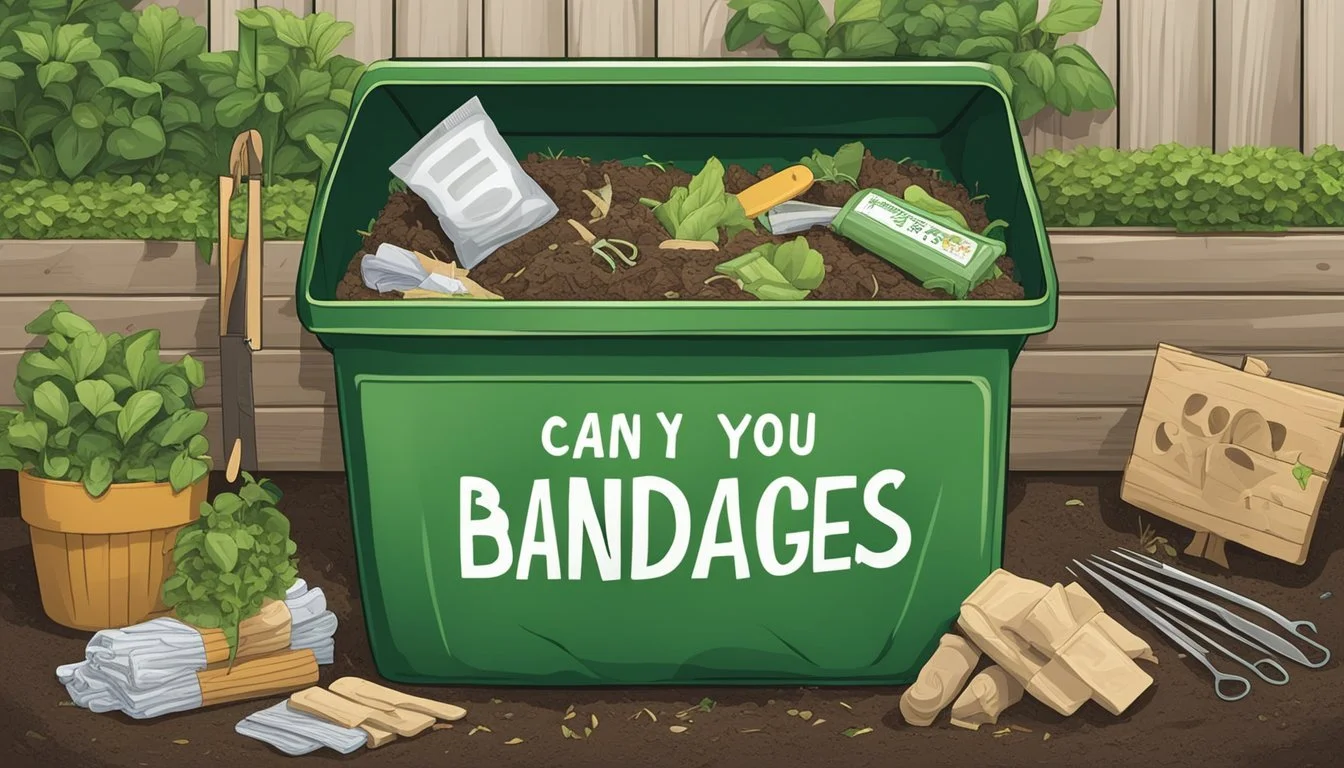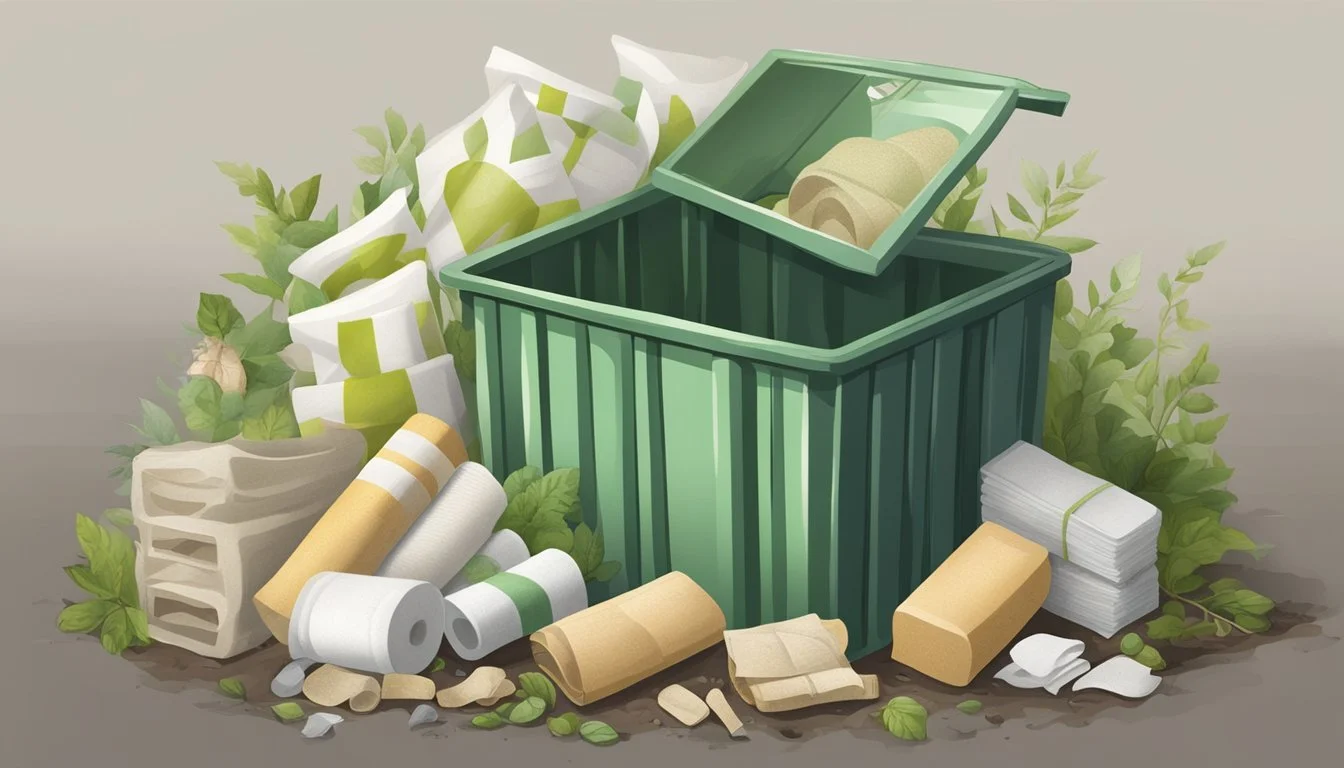Can You Compost Used Bandages?
Understanding Bio-Waste in Home Composting
Composting has become a key solution in reducing waste and benefiting the environment. As households and communities seek sustainable ways to dispose of organic materials, the question arises: can one compost used bandages? Composting, by its nature, involves the breakdown of organic matter by microorganisms, turning waste into nutrient-rich soil. It is an environmentally friendly method to manage waste, but not all materials are suitable for this process.
Standard bandages, typically made of plastic or non-organic materials, do not belong in compost bins. They do not break down like organic waste and can contaminate the compost with pathogens. However, the emergence of eco-friendly bandages made from compostable materials has opened the door to including these items in a compost pile, under specific circumstances. These sustainable alternatives are designed to decompose in an environmentally safe manner, making them an appropriate addition to the composting process as long as they are free from non-compostable adhesives and have not been in contact with harmful pathogens or chemicals.
Understanding Composting
Composting is a key process in waste management that converts organic waste into a nutrient-rich soil amendment through the action of microorganisms.
Basics of Composting
Composting is a biological process where microorganisms break down organic matter into simpler compounds. The fundamental requirement for composting is the presence of organic matter which includes all once-living materials, nitrogen, air, and moisture. Proper mix and management of these elements facilitate the breakdown of materials into compost.
Items Needed for Successful Composting:
Nitrogenous materials (greens): fruit and vegetable scraps, coffee grounds, tea bags, fresh grass clippings
Carbon-rich materials (browns): dried leaves, branches, paper towels, lint from dryers
Microorganisms: naturally occurring in soil and organic waste
Oxygen: provided by turning or mixing the compost pile
Moisture: should be maintained at a level similar to a wrung-out sponge
Types of Compostable Items
Compostable items are generally categorized as greens and browns. Greens are typically high in nitrogen and help microorganisms to thrive and multiply. Browns are rich in carbon and provide the necessary energy for the composting process.
Examples of Compostable Items:
Greens: vegetables, fruit scraps, coffee grounds, eggshells, tea bags
Browns: wine corks, paper towels, cardboard, dry leaves
The Role of Organic Matter
Organic matter is the foundation of composting. It provides the essential components required for the composting process. The decomposition of these materials is propelled by the action of various microorganisms, which requires a balanced mix of nitrogen and carbon to work effectively. This leads to the production of a rich, organic compost that can be used to enhance soil health.
Can You Compost Bandages?
In the context of waste reduction and environmental sustainability, composting bandages depends heavily on their material composition. Natural bandages can often be composted, while synthetic materials present more challenges.
Composting Natural Bandages
Natural bandages made from organic materials such as bamboo fiber are typically compostable. For example, bandages offered by Nutricare are designed to break down in a home composting system. These bandages do not contribute to plastic waste and offer a sustainable alternative for inclusion in a first aid kit. When composting natural bandages, ensure that:
The bandage is fully organic and free of synthetic fibers.
Any adhesive used is also biodegradable.
It's essential to note that not all natural bandages are compostable if they've been used on wounds. Caution should be taken to avoid composting bandages that may have been in contact with blood or bodily fluids due to potential health risks.
Issues with Synthetic Bandage Materials
Bandages made from synthetic materials like PVC, polyethylene, or polyurethane are not suitable for composting. These materials are designed for durability and do not break down easily in a composting environment. Attempting to recycle them can cause several problems:
Contamination of the compost with non-biodegradable particles.
Longer decomposition times disrupting the composting process.
Consumers seeking to decrease their environmental footprint should avoid these materials in favor of natural, compostable options. It is currently not standard practice to recycle synthetic bandages due to the complexity and lack of facilities for processing these materials.
Composting Best Practices
Before diving into the specifics, it's important to recognize that successful composting hinges on creating the ideal balance between waste materials, environmental elements, and maintenance.
Ideal Composting Conditions
To optimize composting, one must establish a sustainable balance of nitrogen-rich greens such as fruit and vegetable scraps, and carbon-rich browns like dried leaves and twigs. The perfect ratio typically skews towards a higher content of browns to ensure effective decomposition. Microorganisms are the workhorses of the composting process, breaking down organic material into usable compost. They thrive in an environment that's rich in air and moisture; thus, maintaining proper aeration and moisture levels is crucial. An ideally maintained compost pile should be moist like a wrung-out sponge.
Essential Elements for Composting:
Greens/Nitrogen: Food scraps, coffee grounds, fresh plant materials
Browns/Carbon: Leaves, straw, wood chips, paper
Environmental Conditions:
Air: Regular turning of the compost pile introduces oxygen needed for microorganisms.
Moisture: Water as necessary to maintain moisture without making the pile too wet.
Maintaining Your Compost Pile
Regular maintenance of a compost pile is key to transforming organic waste into a rich, sustainable soil amendment. This includes turning the pile to introduce air, which boosts microbial activity, and checking moisture levels to keep the materials damp but not soggy. To further aid decomposition and reduce odor, one can incorporate charcoal material from wood ash or crushed, untreated charcoal into the pile.
An effectively maintained compost pile reuses waste, reduces the environmental footprint, and yields a final product beneficial for gardening and soil health. By adhering to these best practices, individuals contribute to a cycle of sustainability that positively impacts the immediate environment while providing long-lasting benefits to the earth.
Alternate Disposal Methods for Bandages
When bandages cannot be added to a composting system, alternative methods such as recycling or regulated waste disposal come into play to minimize environmental impact.
Recycling Options for Non-Compostable Bandages
Non-compostable bandages typically contain plastics like polyvinyl chloride (PVC), polyethylene (PE), or polyurethane (PUR). While household recycling systems generally do not accept these materials, specialized programs may exist. Organizations such as Aid to Hospitals Worldwide collect medical equipment and supplies, potentially providing an avenue for the recycling of unused, out-of-date bandages. They work to ensure that these items are repurposed responsibly, potentially aiding in developing countries' healthcare systems.
Proper Disposal of Medical Waste
Used bandages, regarded as medical waste, pose a risk of contamination and should be disposed of with care. In household settings, soiled bandages should be placed in a separate, sealed bag before adding to the trash to prevent any potential spread of pathogens. Guidelines or services for the disposal of medical waste may vary regionally, so it's critical to follow local regulations to ensure safe and compliant disposal.
Environmental Considerations
The environmental footprint of bandages is important to assess when considering the shift towards sustainability. Traditional bandages contribute to waste, but sustainable options offer a solution that aligns with environmental values.
Impact of Bandages on the Environment
The use of traditional adhesive bandages poses environmental concerns, primarily due to their non-biodegradable materials. These bandages are often made from plastic or a mix of plastic and fabric, which can take hundreds of years to decompose in landfills. The plastic backings, combined with the adhesives and the cotton pad that absorbs blood and other bodily fluids, result in a blend of materials that is challenging to recycle or compost.
Adding to the issue, the production of plastic-based bandages utilizes non-renewable resources and generates carbon emissions. Once disposed of, these bandages may contribute to pollution by breaking down into microplastics that can harm wildlife and contaminate soil and water sources.
Promoting Sustainable Practices
Switching to sustainable bandages is a simple yet impactful way to reduce environmental harm. Compostable bandages, such as those made from organic bamboo fibers, offer an alternative that decomposes more easily in nature. Bamboo grows quickly, requires no pesticides, and consumes less water than cotton, which makes it an eco-friendly resource.
These sustainable bandages often feature adhesives that are hypoallergenic and pressure-sensitive, reducing reactions in individuals with sensitive skin. By choosing compostable bandages, consumers can help ensure that their personal care practices are in line with a commitment to sustainable living.
The move towards sustainable bandages is a reflection of a broader push to reuse, recycle, and compost in ways that align with maintaining environmental integrity. Such practices demonstrate a shift in consumer behavior towards embracing products that are designed with the environment in mind.
Composting Alternatives for Non-Compostable Items
When composting isn't viable for certain materials, one can explore alternative options that support sustainability and reduce waste. These include employing non-compostable items within the garden and finding creative ways to repurpose such items.
Using Non-Compostable Items in the Garden
Non-compostable items can still contribute to a garden's ecosystem in various ways. For instance, certain plastics may serve as an effective mulch to suppress weeds, preserving soil moisture and reducing garden maintenance needs. Moreover, non-compostable materials like sand or pebbles can improve drainage in potting mixes or act as a bottom layer in planters, promoting healthier plant growth.
Creative Reuse and Upcycling
Textiles, such as old clothes or bandages, which are not suitable for composting, can be repurposed through upcycling. Here are some practical suggestions for repurposing fabric-based items:
Bandages: Clean, non-medicated bandages can be reused as plant ties or for gently securing vines to trellises.
Clothes: Worn-out or damaged clothing items can be torn into strips and woven into rugs, crafted into patches for repairing other garments, or transformed into bags or pillow covers.
Upcycling fosters reuse, extending the life of items and diverting them from landfills. This approach not only embodies sustainability but also encourages creative thinking and resourcefulness.








